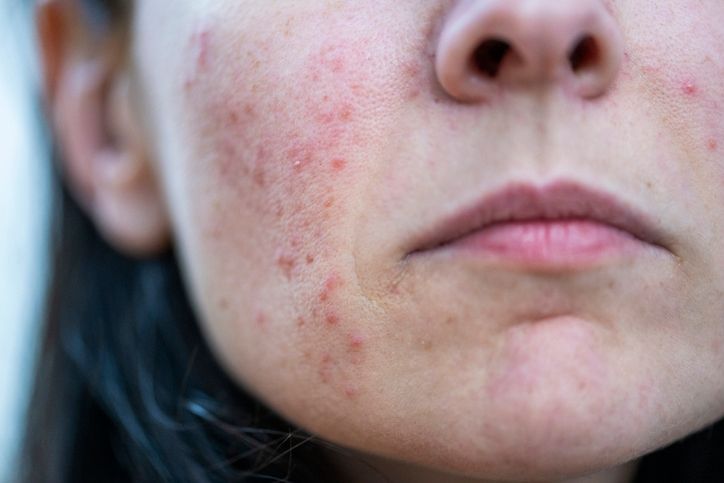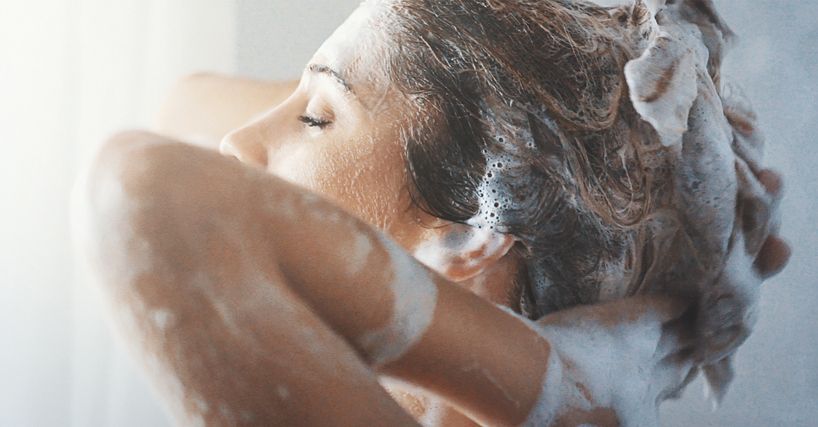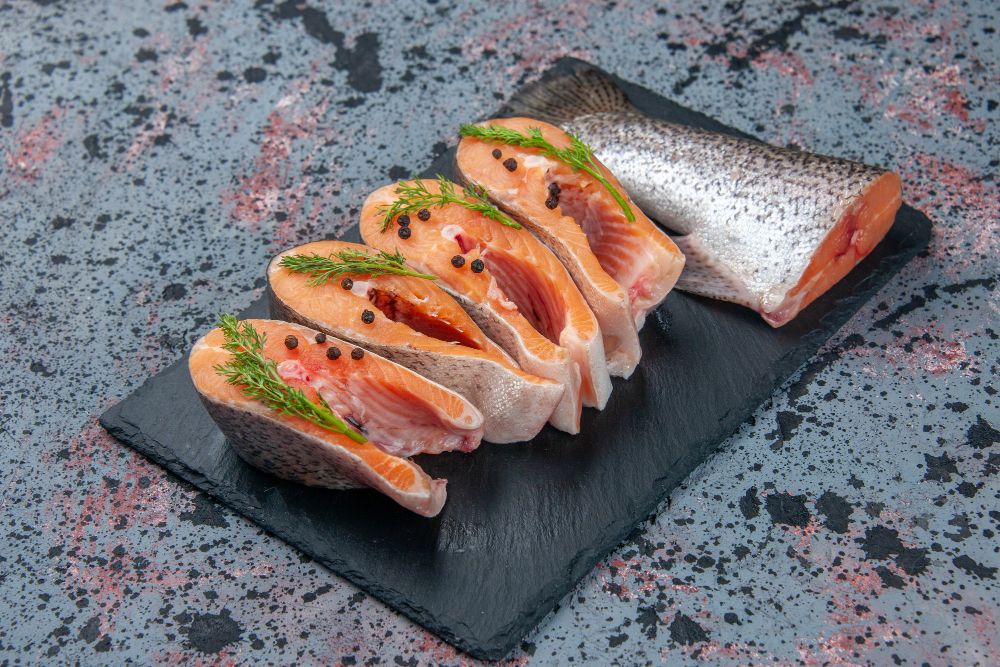Author: Natalie Ng|Updated: 13 May 2025
Sometimes those little bumps on your skin just aren’t acne. They might show up as tiny white spots, rough patches, or red bumps that don’t quite fit the usual breakout pattern. You’ll often notice them on your cheeks, upper arms, or other areas—and while they might feel itchy or rough, they usually have different causes. Dead skin cells, blocked hair follicles, or too much sun can all change how your skin looks and feels. Some bumps are skin-colored, others red, raised, or dome-shaped. Most aren’t serious, but a few can look a lot like early signs of skin cancer or other health issues, so it’s good to know what you’re dealing with. Ahead, we’ll go over five common skin conditions that cause bumps but aren’t acne—so you can figure out what’s happening and what might help.

Keratosis Pilaris: Rough Bumps on Cheeks and Skin Texture Changes
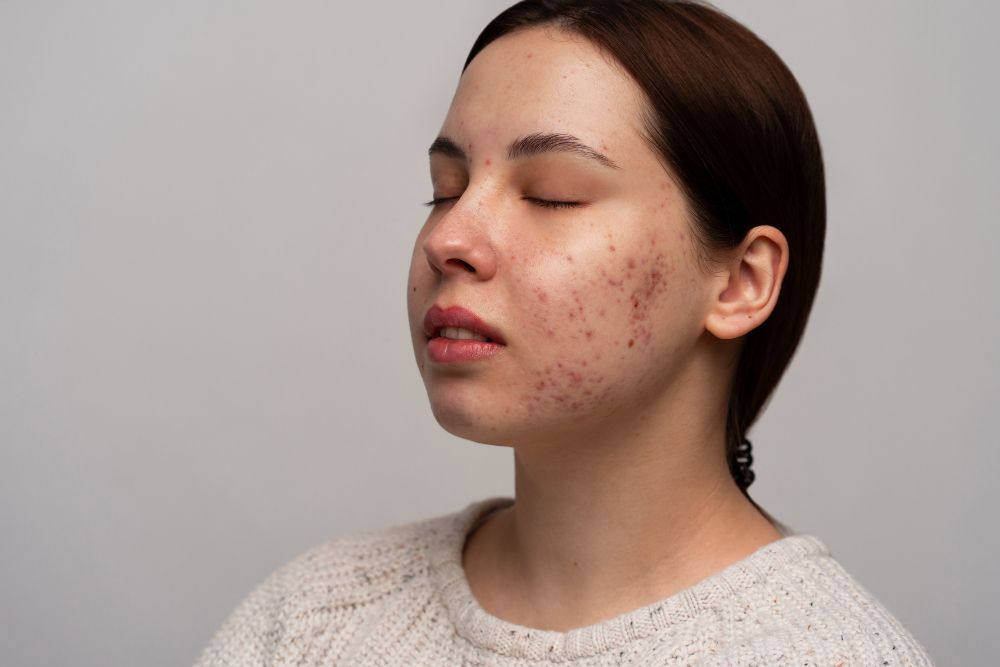
Signs of keratosis pilaris on the face
Rough facial bumps often show up along the cheeks and jawline. These bumps feel dry or slightly raised, like sandpaper. They tend to be small, skin colored, or red. On dark skin, the bumps can appear darker and may leave behind uneven skin tone.
Buildup of dead skin and keratin in hair follicles
Keratosis pilaris develops when dead skin and keratin block hair follicles. This buildup creates tiny plugs under the skin's surface, leading to rough patches. These bumps are not caused by clogged pores or oil glands, and they don’t swell or form whiteheads like acne.
Factors that make facial bumps more visible
Dry air, sun exposure, and strong skincare products can make bumps more noticeable. Using harsh exfoliants or skipping moisturizer also makes the skin feel rougher. People with atopic dermatitis or a family history of skin conditions often see more flare-ups.
Skincare ingredients that reduce facial roughness
Use a gentle cleanser and non-irritating moisturizer to prevent dryness. Ingredients like salicylic acid, glycolic acid, and lactic acid help dissolve buildup on the skin’s surface. Products with urea or ceramides help support the skin barrier and soften rough bumps.
Daily sunscreen is important—excessive sun exposure can worsen uneven skin texture. While keratosis pilaris may not go away completely, a simple skincare routine can help smooth the affected areas and reduce visible bumps.

Milia: Tiny White Bumps Below the Skin's Surface
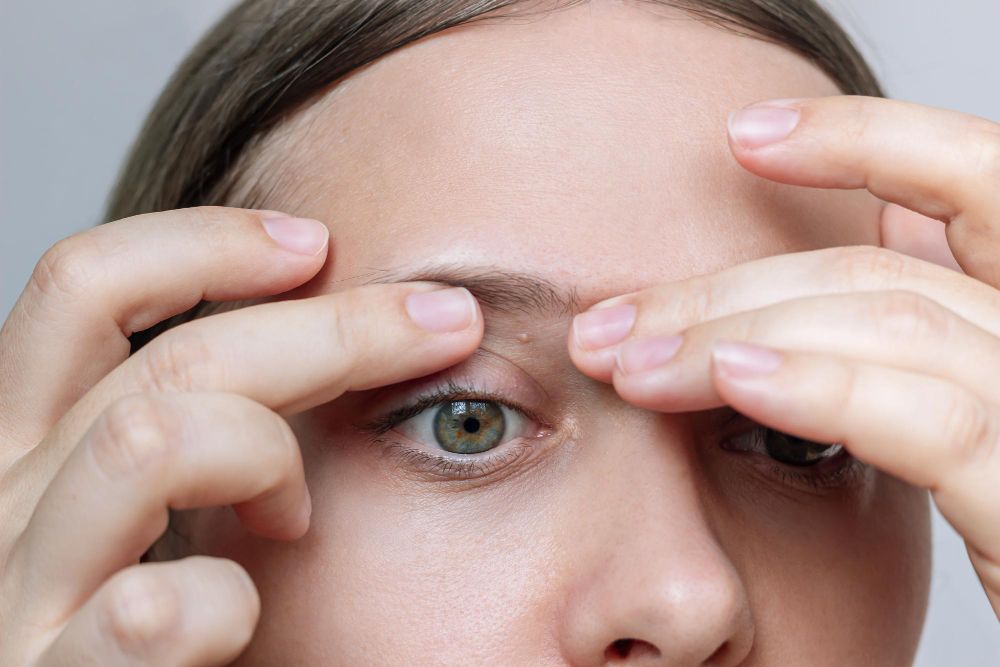
Signs of milia and where they appear
Milia are small white bumps that form just under the skin. They often show up on the face—especially around the eyes, cheeks, nose, and forehead—but can also appear on other parts of the body. These bumps look like white pearls or tiny cysts and are usually smooth, firm, and skin colored or white.
Dead skin cells trapped beneath the skin
Milia form when dead skin cells get trapped under the skin’s surface instead of shedding naturally. These cells harden and form small cysts that sit just below the outer layer of skin. Unlike acne, they don’t involve bacteria, pus, or oil from sebaceous glands. They aren’t red or inflamed, and they don’t cause pain or swelling.
Triggers and risk factors for milia
Adults may develop milia after skin trauma, burns, or cosmetic procedures that damage the skin tissue. Using heavy creams or products that block pores can also lead to buildup. Excessive sun exposure may make skin less able to shed dead cells properly, increasing the chance of milia.
People with dry or thickened skin, especially around the eyes or cheeks, may be more likely to get these bumps. In newborns, milia are common and usually go away without treatment, but adult milia can stick around longer.
Treatment options for persistent facial bumps
Most milia don’t need treatment and will eventually fade. But if the bumps stay, especially in visible areas like the cheeks or under the eyes, removal by a healthcare provider may be needed. Common treatment options include manual extraction, topical retinoids, or chemical exfoliants like glycolic acid.
Avoid picking at the bumps or trying to squeeze them—they don’t open like acne and can leave marks if damaged. A gentle skincare routine using a mild exfoliant or gentle soap can help reduce buildup over time. Wearing sunscreen may also help protect the skin and prevent more bumps from forming.
Read More
Book Now to Experience
Acne Treatment
1 Minute Self-Registration
Date should not be before minimal date

Seborrheic Keratosis: Raised Skin Bumps That Develop With Age
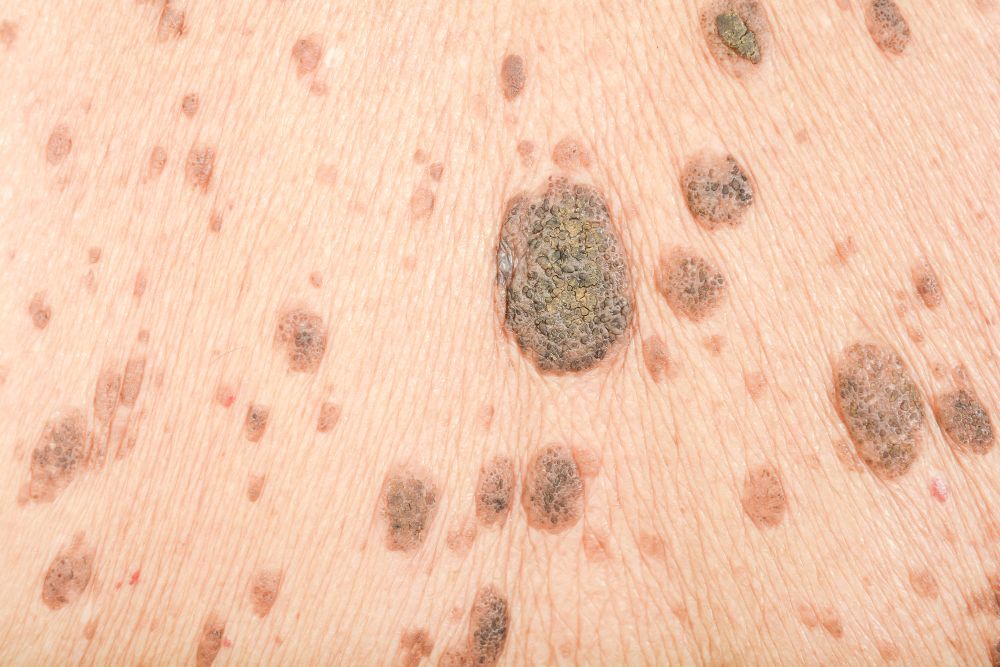
Features of age-related raised patches
Seborrheic keratosis appears as rough, raised skin bumps that look like they’re sitting on top of the skin. These spots are usually tan, brown, or black and vary in size—from small specks to patches the size of a pencil eraser or larger. They often have a waxy or scaly surface and may feel dry or uneven.
These growths show up on the face, chest, back, neck, or arms and tend to increase in number over time. Some look flat, while others are dome shaped or slightly textured. They can resemble skin tags, rough moles, or dried scabs.
Build-up of skin cells on the surface
Seborrheic keratoses form when skin cells multiply in clusters and stick together on the skin’s surface. These bumps are not caused by dead skin cells, clogged pores, or oil gland issues. They do not signal cancer, though their appearance can sometimes raise concern.
These growths often start appearing after the age of 40 and become more common with excessive sun exposure or aging skin tissue. While the exact cause isn’t fully known, they tend to run in families.
Skin irritation and cosmetic concerns
Most seborrheic keratoses are painless, but they may itch or become irritated—especially when rubbed by clothes or jewelry. Some people choose to remove them if they’re in visible areas like the face or neck, or if they snag easily.
Common treatment methods for removal
These bumps don’t require treatment unless they cause discomfort or affect appearance. A healthcare provider can safely remove them using:
• Cryotherapy with liquid nitrogen
• Curettage to gently scrape the area
• Electrocautery to burn off the bump
• Laser therapy for smoother skin
New bumps can form over time, especially in areas with sun damage. Wearing sunscreen daily may help reduce excessive sun exposure and protect the skin’s surface from further changes.

Folliculitis: Red Bumps From Inflamed Hair Follicles
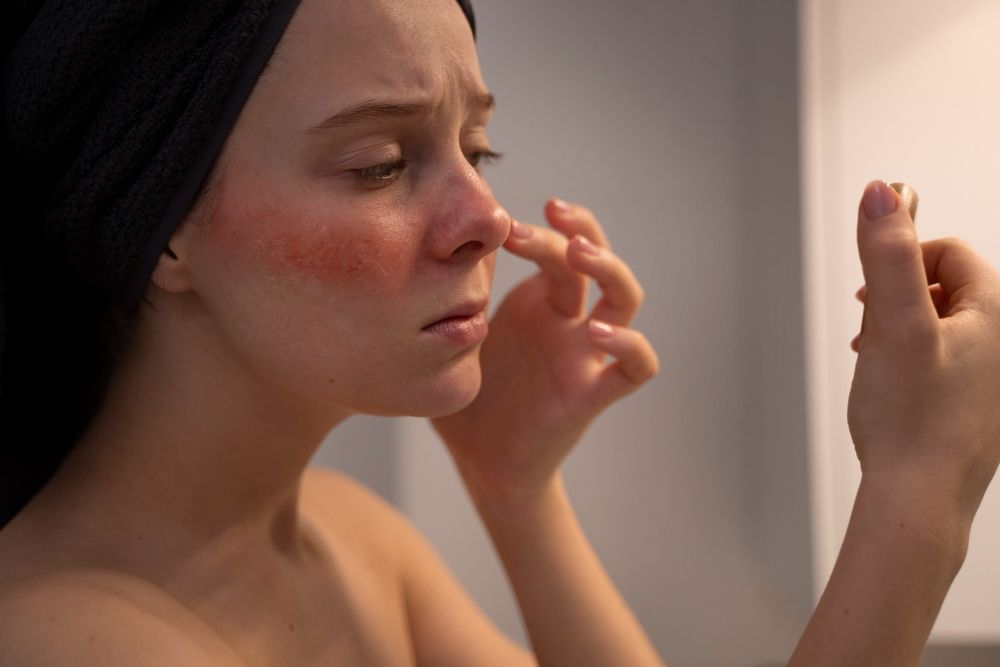
Signs of folliculitis on the skin
Folliculitis looks like clusters of small red bumps or white-headed spots that form around hair follicles. These raised skin bumps can appear on the neck, chest, thighs, or groin—anywhere that’s exposed to friction, sweat, or shaving. They may feel itchy or sore and often come with mild swelling or a burning sensation.
In darker skin tones, the bumps may appear darker or leave behind spots after healing. Some cases look like razor burn or ingrown hairs but are caused by irritation or infection inside the follicle.
Causes linked to skin irritation and bacteria
Folliculitis happens when hair follicles get inflamed. This can be caused by bacteria, fungi, or yeast, especially when skin is damaged or blocked. Tight clothing, excessive sweating, or shaving with a dull razor can increase irritation. Using heavy products that clog pores may also make things worse.
People with thick body hair, active lifestyles, or frequent shaving are more likely to develop this skin condition. Those with existing skin conditions like atopic dermatitis may also experience more frequent flare-ups.
Importance of keeping the skin clean and calm
Mild cases often go away on their own. Keeping the affected areas clean, dry, and free from friction helps reduce inflammation. Warm compresses can soothe the bumps, while avoiding shaving or wearing tight clothes allows the skin to heal.
For recurring bumps, switch to antibacterial soap, use a clean razor, and wear looser fabrics to reduce friction. Using a gentle cleanser and avoiding harsh scrubs can also help protect the skin’s surface from damage.
Treatment for stubborn or widespread bumps
If the bumps don’t clear, or if they spread, a healthcare provider may suggest treatment with:
• Topical antibiotics
• Antifungal creams
• Oral medication for deeper infections
Preventing future flare-ups starts with maintaining a simple, non-irritating skincare routine and avoiding products that clog hair follicles or irritate skin tissue.
Book Now to Experience
Acne Treatment
1 Minute Self-Registration
Date should not be before minimal date

Contact Dermatitis: Red, Itchy Bumps From Skin Reactions

Skin reactions that cause red bumps and rashes
Contact dermatitis appears as red bumps, rashes, or patches of irritated skin. These areas may burn, itch, swell, or feel dry and cracked. The bumps usually show up on the hands, face, neck, or any skin that came into contact with a trigger.
On dark skin, the rash may look darker, raised, or uneven. In some cases, the bumps may blister or peel, especially if the skin is scratched or exposed for long periods.
Allergic reactions and skin irritation
This condition develops when the skin reacts to certain substances. Irritant contact dermatitis is triggered by harsh chemicals like cleaning products, soaps, or solvents. Allergic contact dermatitis is caused by a delayed immune response to allergens like fragrances, nickel, or plants such as poison ivy.
The skin’s surface becomes inflamed after repeated or direct exposure, and symptoms may appear immediately or up to two days later. Overwashing, not using a gentle soap, or skipping moisturizer can weaken the skin barrier, making it more reactive.
Common triggers and affected areas
Triggers include:
• Soaps and detergents with strong surfactants
• Fragranced skincare or hair products
• Jewelry made of nickel or other reactive metals
• Latex, dyes, or preservatives
• Plants and airborne allergens
The affected areas may match the shape of the object or material that caused the reaction—for example, bumps in the shape of a watch strap or phone screen.
Treatment options and prevention steps
Most mild cases can be managed at home. Use a gentle cleanser and avoid scrubbing the area. Applying over-the-counter hydrocortisone cream can help reduce inflammation and itching. Moisturizers help repair the skin barrier, especially if they contain ingredients like ceramides.
For ongoing flare-ups, a healthcare provider may recommend:
• Stronger corticosteroids
• Barrier creams
• Patch testing to identify triggers
Wearing sunscreen daily can help protect weakened skin from further damage, especially after inflammation. To avoid future reactions, stop using any product or material that caused symptoms and choose fragrance-free, non-irritating skincare products.

Difference Between Acne and Other Common Skin Bumps
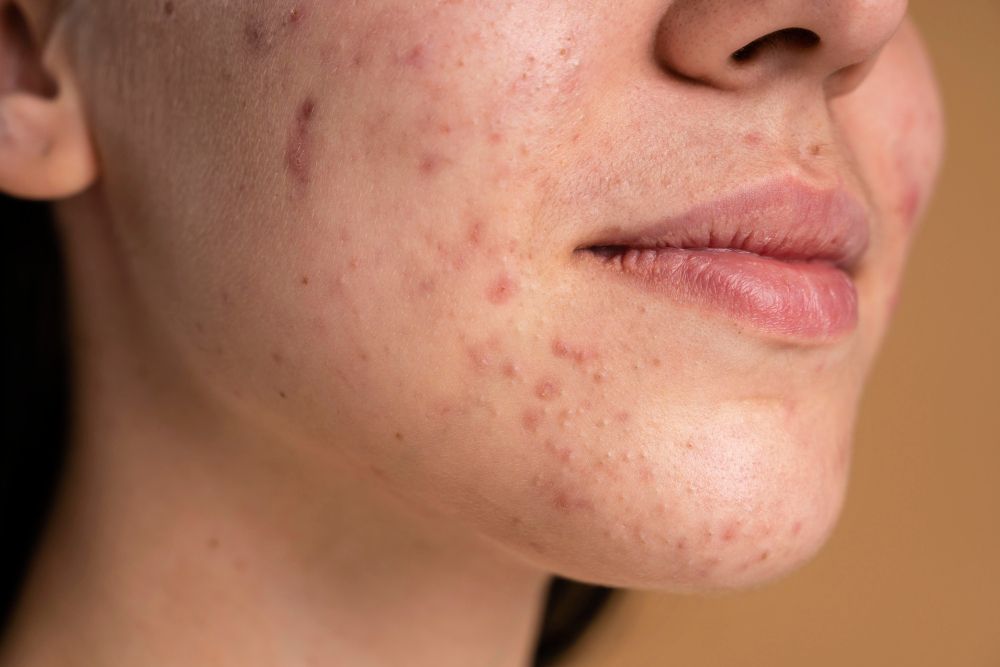
Why acne and non-acne bumps often get mixed up
Not every bump on your face is acne—even if it shows up in breakout-prone areas like the cheeks or forehead. Acne bumps usually involve clogged pores, excess oil from sebaceous glands, and bacteria. They often look red, swollen, or come to a head. But many skin conditions, like keratosis pilaris, milia, or contact dermatitis, also cause small bumps—without any of those features.
These conditions may look similar at first, especially if the bumps appear in clusters or feel rough. But acne has a different root cause and responds to very different treatments.
Key differences on the skin’s surface
• Acne often includes blackheads, whiteheads, papules, or pustules. It may cause swelling, pain, or inflammation and commonly affects the T-zone, chin, back, and chest.
• Keratosis pilaris creates rough bumps, usually on the cheeks or upper arms, without oil or pus.
• Milia forms tiny white bumps from trapped dead skin cells—not oil or bacteria.
• Folliculitis may look like acne but involves infected hair follicles and can be painful.
• Contact dermatitis causes red, itchy bumps that appear after skin reacts to a product or allergen.
Each condition has different triggers, from allergic reactions and blocked hair follicles to sun damage or harsh skincare products.
Importance of the right treatment approach
Using acne treatment on bumps that aren’t acne-related can dry out or irritate the skin. Ingredients like benzoyl peroxide may not help if the bump is caused by trapped keratin or skin inflammation. That’s why it’s important to look closely at the skin’s texture, location, and symptoms before starting treatment.
Book Now to Experience
Acne Treatment
1 Minute Self-Registration
Date should not be before minimal date

Ingredients That Help With Both Acne and Non-Acne Skin Bumps
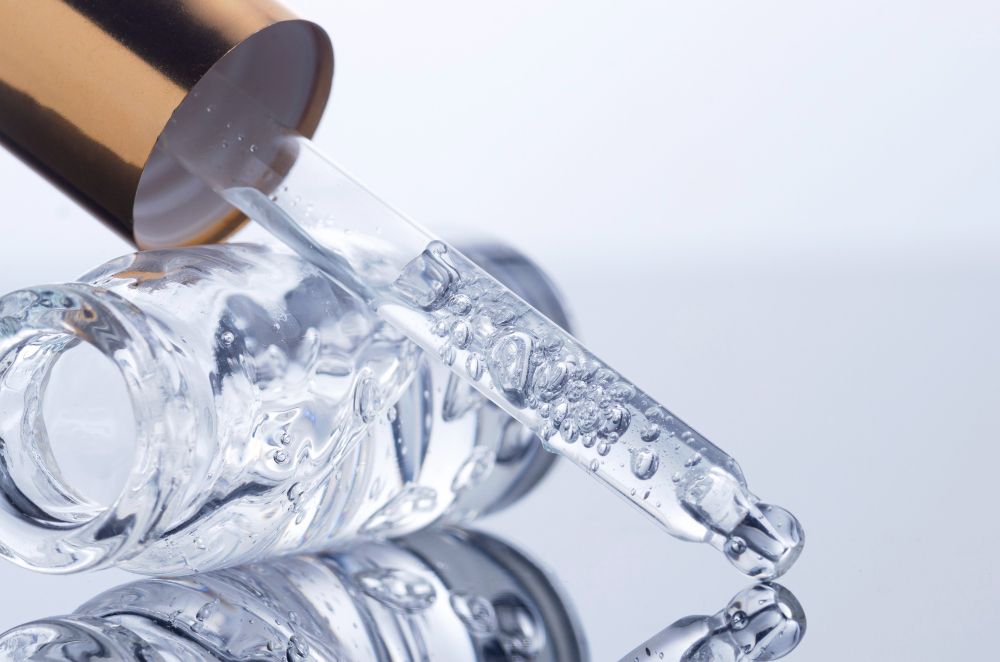
Multi-use ingredients for smoother skin
Some skincare ingredients work across different types of skin bumps—not just acne. While not every bump responds to traditional acne treatments, certain ingredients can help improve rough skin, clogged pores, or dead skin buildup. Choosing the right ones can make a noticeable difference in both texture and appearance.
Glycolic acid and other exfoliants
Glycolic acid is an alpha hydroxy acid that helps remove dead skin cells from the skin’s surface. It improves uneven texture caused by acne and also helps smooth rough bumps linked to keratosis pilaris or milia. It’s especially useful on cheeks, upper arms, or the forehead, where these small bumps often appear.
Lactic acid offers similar benefits and is gentler on dry or sensitive skin. It can help loosen trapped skin cells in the early stages of milia and soften sandpaper-like bumps without causing irritation.
Salicylic acid and oil control
Salicylic acid is a beta hydroxy acid that targets clogged pores and excessive oil. It’s effective for acne but can also help reduce buildup around hair follicles, especially in folliculitis. It gently exfoliates while reducing inflammation and works well in cleansers or leave-on treatments.
For bumps that aren’t inflamed, salicylic acid still helps by keeping the skin’s surface clear and preventing pore blockages.
Urea and moisturizers for rough patches
Urea softens and hydrates dry, rough skin. It helps break down hardened keratin in keratosis pilaris and improves flaking or tightness after bumps heal. It’s especially useful on areas like the upper arms or cheeks where skin tends to feel rough or dry.
When combined with a gentle skincare routine, these ingredients support healthier skin texture without triggering irritation.
Choosing the right ingredient for your skin type
Not all bumps need aggressive treatment. Products with these ingredients can be used in low concentrations for maintenance or prevention. For example:
• Use glycolic acid a few times per week to smooth uneven skin.
• Choose a gentle salicylic acid cleanser to control small bumps and clogged pores.
• Apply urea-based moisturizers daily on areas that feel rough or dry.
Avoid mixing too many actives at once. If irritation or redness starts, scale back and focus on repairing the skin barrier with a gentle cleanser and basic moisturizer.

New Beauty’s Acne Treatment—Targeting Little Bumps, Clogged Pores, and Oily Skin
Why this treatment helps with more than just acne
If you're dealing with little bumps on your face that won’t go away—whether it's acne, whiteheads, clogged pores, or rough patches—The Acne Treatment can help clear your skin and improve its texture. These bumps are often caused by a mix of dead skin cells, excess oil, and buildup in the hair follicles. Regular skincare may not reach deep enough, but this treatment is designed to work below the surface without causing irritation.
How the treatment works
The Acne Treatment combines dual spiral suction with a drainage system to exfoliate dead skin, clear out impurities, and reduce inflammation in the affected areas. This process deeply cleans the pores and removes trapped oil, dirt, and dead skin that contribute to both acne and other raised skin bumps.
After cleansing, a medical-grade hydrating serum is infused into the skin. This helps calm overactive sebaceous glands, rebalances moisture levels, and encourages healthy skin tissue repair. The treatment is non-invasive and suitable for acne-prone, oily, or textured skin, including those with facial bumps not caused by active acne.
Benefits for textured, acne-prone, and sensitive skin
• Clears clogged pores and removes buildup that causes rough bumps
• Calms inflammation in the skin without the need for oral medication
• Hydrates the deeper skin layers to reduce dryness and flaking
• Helps balance oil production to prevent future breakouts
• Improves the look of acne scars, pockmarks, and dull skin tone
• No downtime or irritation—skin feels cleaner and smoother after each session
Boost results with regular sessions
The Acne Treatment works best when done consistently, especially for those with recurring bumps, whiteheads, or stubborn acne scars. Most people see visible improvements after a few sessions as the treatment helps keep the skin’s surface clear and balanced.
Book the Acne Treatment today to find out if this treatment is right for your skin. A smoother, clearer complexion starts with the right care.
New Beauty's Acne TreatmentBook Now to Experience
Acne Treatment
1 Minute Self-Registration
Date should not be before minimal date
FAQ
1. Why do I have little bumps on my face but no acne?
Little bumps on the face that don’t respond to acne treatment are often caused by conditions like milia, keratosis pilaris, or clogged hair follicles. These bumps may be skin colored, rough, or dome shaped, and they don't always involve inflammation. Dead skin cells trapped under the surface, allergic reactions, or buildup around oil glands can also lead to facial bumps that look like acne but behave differently.
2. Can I use acne products on rough bumps or white bumps?
Not always. Products with benzoyl peroxide or strong acne treatments can dry out or irritate skin that has bumps from other conditions like milia or keratosis pilaris. If the bumps are caused by dead skin or keratin buildup, exfoliating agents like salicylic acid or glycolic acid may help—but only when used gently. It’s important to identify the cause of the bumps before choosing a treatment.
3. Are raised skin bumps a sign of skin cancer?
Most small skin bumps are harmless, especially if they’re stable in size and not bleeding or changing in color. But some raised skin bumps, like seborrheic keratoses or cherry hemangiomas, can resemble more serious conditions. If you notice changes in shape, color, or texture—or if a bump looks very different from others on your body—it’s best to have it checked by a healthcare provider.
4. Do bumps on dark skin look different than on light skin?
Yes. On dark skin, small bumps or rough patches may appear darker or more raised than on lighter skin. Inflammation can leave behind dark marks (post-inflammatory hyperpigmentation) that linger even after the bumps fade. Because of this, gentle skincare and avoiding harsh scrubbing is especially important when treating skin conditions on dark skin tones.
5. How can I prevent clogged pores and small cysts from coming back?
Stick to a skincare routine with a gentle cleanser and non-comedogenic products. Avoid using heavy or oily creams that can block pores or trap dead skin. Regular exfoliation with mild acids like salicylic acid or lactic acid can help keep the skin’s surface clear. Also, wearing sunscreen daily helps protect the skin from damage that can make clogged pores and rough skin more noticeable.
Recommended Articles
COPYRIGHT© NEW BEAUTY MANAGEMENT LIMITED 2025. ALL RIGHT RESERVED.

